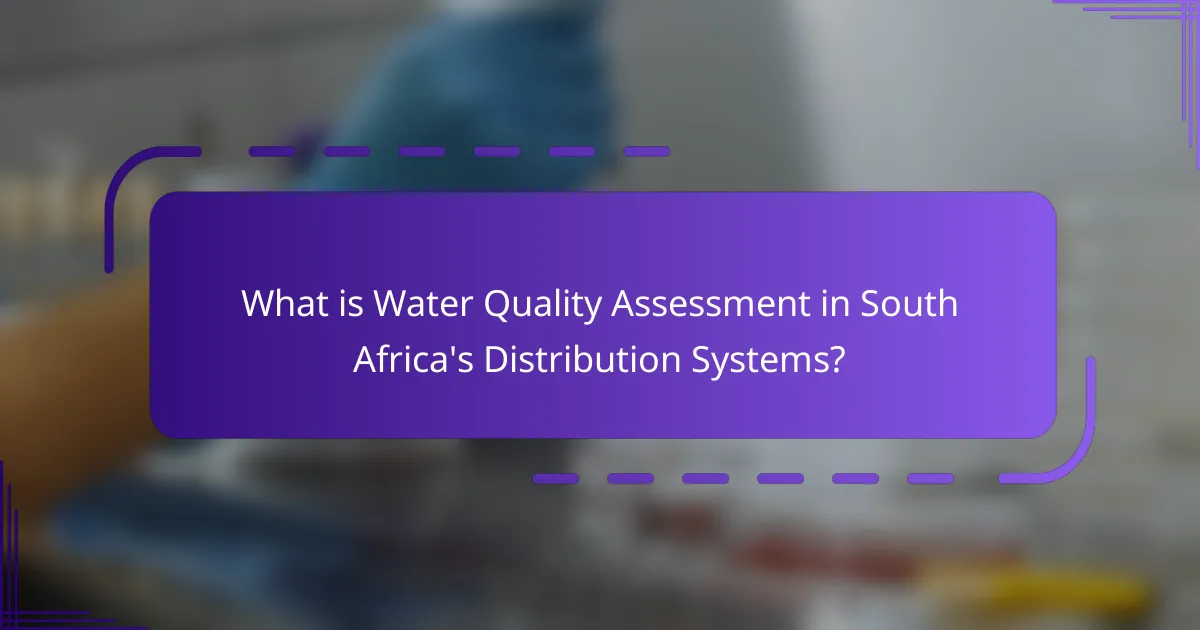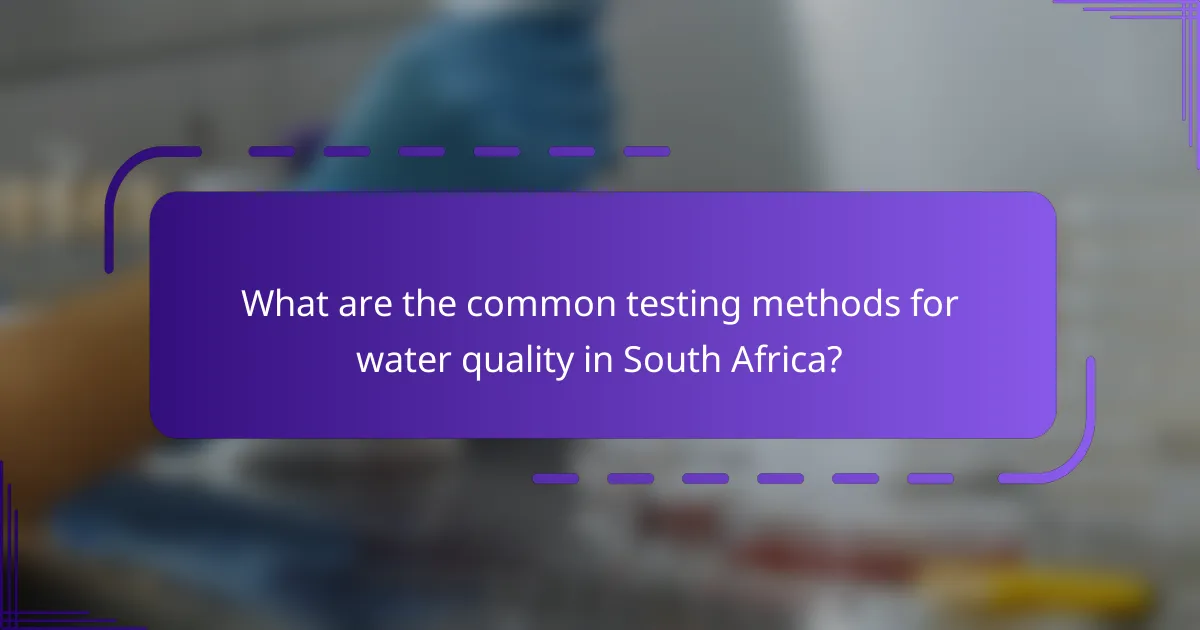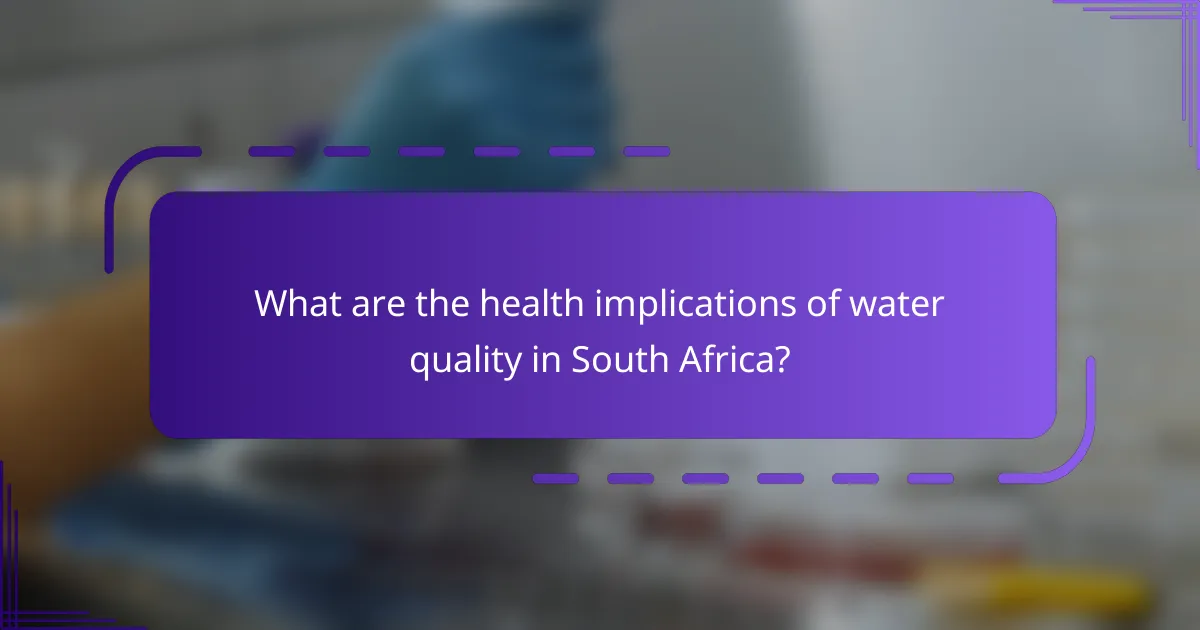Water Quality Assessment in South Africa’s Distribution Systems involves the systematic evaluation of water quality to ensure it meets safety standards for human consumption. This process includes testing for chemical composition, microbial contamination, and physical characteristics, guided by the National Water Act and Drinking Water Quality Guidelines. Regular monitoring is essential to identify health risks associated with contaminated water, which can lead to diseases such as cholera and typhoid fever. Common testing methods include physical, chemical, and microbiological analyses, with standards set by the South African National Standards (SANS). The article highlights the importance of effective water quality assessment in safeguarding public health and reducing waterborne diseases.

What is Water Quality Assessment in South Africa’s Distribution Systems?
Water Quality Assessment in South Africa’s Distribution Systems refers to the systematic evaluation of the quality of water supplied through distribution networks. This assessment involves testing for various parameters such as chemical composition, microbial contamination, and physical characteristics. The aim is to ensure that the water meets national and international safety standards for human consumption. South Africa’s National Water Act and the Drinking Water Quality Guidelines provide the regulatory framework for these assessments. Regular monitoring is crucial to identify potential health risks and to maintain public confidence in water supply systems. Studies indicate that effective water quality assessment can significantly reduce waterborne diseases and enhance overall public health outcomes.
Why is assessing water quality important for public health?
Assessing water quality is crucial for public health because contaminated water can lead to serious health issues. Poor water quality is linked to diseases such as cholera and dysentery. According to the World Health Organization, 2 billion people use a drinking water source contaminated with feces. Regular assessment helps identify harmful contaminants, ensuring safe drinking water. It also aids in monitoring compliance with health standards. Effective water quality assessment can prevent outbreaks and reduce healthcare costs. In South Africa, maintaining water quality is vital due to historical challenges with waterborne diseases.
What are the key components of water quality that need assessment?
The key components of water quality that need assessment include physical, chemical, and biological parameters. Physical parameters consist of temperature, turbidity, and color. Chemical parameters include pH, dissolved oxygen, and concentrations of contaminants like nitrates and heavy metals. Biological parameters involve the presence of pathogens and microorganisms. Assessing these components ensures compliance with safety standards and protects public health. For example, the World Health Organization sets guidelines for acceptable levels of contaminants in drinking water. Regular monitoring of these components is crucial for maintaining safe water quality.
How does water quality impact the environment and communities?
Water quality significantly impacts the environment and communities. Poor water quality can lead to health issues in populations, including gastrointestinal diseases. Contaminated water sources affect aquatic ecosystems, harming biodiversity. Polluted water can disrupt food chains, leading to fish kills and loss of habitat. Additionally, communities reliant on contaminated water face economic challenges. Clean water is essential for agriculture, affecting food security. Research indicates that improved water quality can enhance public health outcomes. For example, a study published by the World Health Organization shows that access to safe drinking water can reduce waterborne diseases by up to 90%.
What standards govern water quality in South Africa?
The standards that govern water quality in South Africa are primarily set by the National Water Act and the Water Services Act. These acts establish regulations for water quality management and set limits for various contaminants. The South African Bureau of Standards (SABS) also provides specific guidelines through SANS 241, which outlines the quality requirements for drinking water. Compliance with these standards is monitored by the Department of Water and Sanitation. Furthermore, the World Health Organization (WHO) guidelines for drinking water quality are often referenced to ensure safety. Regular testing and assessments are conducted to ensure adherence to these standards.
Which organizations set these water quality standards?
The organizations that set water quality standards include the World Health Organization (WHO) and the South African National Standards (SANS). The WHO provides international guidelines for drinking-water quality. These guidelines are based on comprehensive research and aim to protect public health. In South Africa, SANS develops specific standards for water quality. These standards are aligned with WHO recommendations and are enforced by the Department of Water and Sanitation.
What are the specific criteria included in these standards?
The specific criteria included in these standards focus on various water quality parameters. These parameters include microbial contamination levels, chemical composition, and physical characteristics. Microbial criteria assess the presence of pathogens such as E. coli and total coliforms. Chemical criteria evaluate contaminants like heavy metals, nitrates, and pesticides. Physical criteria involve turbidity, color, and odor measurements. South Africa’s National Water Act and SANS 241 provide guidelines for acceptable limits for these parameters. Compliance with these standards ensures safe drinking water for the population.

What are the common testing methods for water quality in South Africa?
Common testing methods for water quality in South Africa include physical, chemical, and microbiological analyses. Physical tests assess parameters like turbidity, color, and temperature. Chemical tests measure substances such as pH, dissolved oxygen, and heavy metals. Microbiological tests detect pathogens like E. coli and coliform bacteria. The South African National Standards (SANS) outline procedures for these tests. Laboratories often use methods like spectrophotometry and chromatography for chemical analysis. Field tests provide immediate results for certain parameters. Regular monitoring ensures compliance with health regulations. These methods collectively help safeguard public health and ensure water safety in South Africa.
How are physical, chemical, and biological tests conducted?
Physical, chemical, and biological tests are conducted to assess water quality. Physical tests measure attributes like turbidity and temperature using instruments such as turbidity meters and thermometers. Chemical tests analyze substances like pH, dissolved oxygen, and contaminants using methods like titration and spectrophotometry. Biological tests evaluate the presence of microorganisms through culture methods and molecular techniques. Each testing method follows standardized procedures to ensure accuracy and reliability. These standards are often set by organizations like the World Health Organization. Testing results inform water treatment processes and ensure compliance with health regulations.
What equipment and technologies are used in these tests?
Various equipment and technologies are utilized in assessing water quality in South Africa’s distribution systems. Commonly used tools include spectrophotometers for measuring chemical concentrations. Turbidimeters assess water clarity by measuring light scattering. pH meters determine the acidity or alkalinity of water samples. Dissolved oxygen meters measure oxygen levels essential for aquatic life. Conductivity meters assess the ionic content of water. Additionally, microbiological testing kits detect harmful pathogens. These technologies ensure compliance with health and safety standards, providing accurate data for effective water quality management.
How often should water quality testing be performed?
Water quality testing should be performed at least once a year. This frequency helps ensure that water remains safe for consumption and meets health standards. According to the World Health Organization, regular testing is crucial for identifying contaminants. More frequent testing may be necessary in areas with known pollution issues or after natural disasters. The South African National Standards recommend quarterly testing for certain water sources. These guidelines help maintain public health and safety in water distribution systems.
What are the challenges faced in water quality testing?
Water quality testing faces several challenges. Contamination from various sources complicates accurate testing. Sample collection can be inconsistent, leading to unreliable results. The presence of multiple contaminants requires comprehensive testing methods. Limited access to advanced testing technology hampers effective analysis. Regulatory standards may vary, causing confusion in compliance. Additionally, the costs associated with testing can strain resources. Finally, training and expertise in testing methods are often insufficient. These factors collectively impact the reliability of water quality assessments.
What factors can affect the accuracy of testing methods?
Factors that can affect the accuracy of testing methods include sample contamination, equipment calibration, and environmental conditions. Sample contamination occurs when external substances interfere with the test results. Equipment calibration is crucial; uncalibrated instruments can produce erroneous readings. Environmental conditions, such as temperature and humidity, can also impact test accuracy. Additionally, the skill level of the personnel conducting the tests plays a significant role. Human error can lead to misinterpretation of results or incorrect sample handling. These factors collectively influence the reliability of water quality assessments in distribution systems.
How do logistical issues impact water quality assessments?
Logistical issues significantly impact water quality assessments by affecting sample collection, transportation, and analysis. Delays in sample collection can lead to changes in water quality, such as the growth of bacteria. Inadequate transportation conditions may compromise sample integrity, introducing contamination. Limited access to testing facilities can result in increased turnaround times for results. Additionally, insufficient funding can restrict the availability of necessary equipment and trained personnel. All these factors can ultimately lead to inaccurate assessments of water quality. Accurate water quality assessments are crucial for public health and environmental protection.

What are the health implications of water quality in South Africa?
Poor water quality in South Africa poses significant health risks. Contaminated water can lead to diseases such as cholera, dysentery, and typhoid fever. The South African Department of Water and Sanitation reported that inadequate sanitation and pollution contribute to these health issues. High levels of pathogens in water sources are a primary concern. Additionally, heavy metals like lead and mercury can cause long-term health problems. Vulnerable populations, including children and the elderly, are at greater risk. Access to clean water is essential for public health. Regular monitoring and improved infrastructure are crucial for mitigating health risks associated with poor water quality.
How do poor water quality levels affect public health?
Poor water quality levels significantly impact public health. Contaminated water can lead to a variety of diseases. These include gastrointestinal infections, cholera, and dysentery. According to the World Health Organization, unsafe drinking water causes over 500,000 deaths each year from diarrheal diseases. Additionally, long-term exposure to contaminated water can result in chronic health issues, including kidney damage and reproductive problems. In South Africa, inadequate water treatment and pollution contribute to these health risks. The presence of pathogens and harmful chemicals in water supplies is a direct threat to community health. Effective monitoring and improvement of water quality are essential to safeguard public health.
What are the common waterborne diseases associated with low water quality?
Common waterborne diseases associated with low water quality include cholera, dysentery, and typhoid fever. Cholera is caused by the bacterium Vibrio cholerae and leads to severe diarrhea and dehydration. Dysentery, often caused by Shigella bacteria or amoebas, results in bloody diarrhea and abdominal pain. Typhoid fever is caused by Salmonella typhi and presents with high fever, weakness, and gastrointestinal issues. These diseases are prevalent in areas with poor sanitation and contaminated water sources. According to the World Health Organization, approximately 2 billion people globally lack access to safe drinking water, increasing the risk of these diseases. Proper water treatment and sanitation practices can significantly reduce the incidence of waterborne diseases.
How can communities mitigate health risks related to water quality?
Communities can mitigate health risks related to water quality by implementing regular water testing and monitoring. This ensures that contaminants are identified promptly. Educating residents about safe water practices is also crucial. Communities should promote proper sanitation and hygiene to reduce waterborne diseases. Infrastructure improvements, such as upgrading pipes and treatment facilities, can enhance water quality. Engaging local stakeholders can foster community involvement and awareness. According to the World Health Organization, effective water management reduces health risks significantly. These strategies collectively contribute to safer water access and improved public health outcomes.
What role do government and NGOs play in improving water quality?
Governments and NGOs play crucial roles in improving water quality. Governments establish regulations and standards for water quality. They enforce laws to protect water sources and ensure safe drinking water. For example, the South African government has implemented the National Water Act to manage water resources effectively. NGOs often engage in community education and awareness programs. They also conduct research and advocacy to influence policy changes. An example is the Water Research Commission in South Africa, which supports water quality research. Together, these entities work to monitor water quality and promote sustainable practices. Their efforts contribute to better health outcomes for communities.
How can community engagement enhance water quality initiatives?
Community engagement can enhance water quality initiatives by fostering local ownership and responsibility. When communities are involved, they become more invested in maintaining clean water sources. Engaged citizens can identify pollution sources and advocate for better practices. Studies show that community-led monitoring programs can lead to improved water quality outcomes. For instance, the Water Research Commission in South Africa emphasizes community participation in monitoring efforts. This participation not only raises awareness but also promotes transparency in water management. Engaged communities can also collaborate with local authorities to implement effective solutions. Overall, community engagement is crucial for sustainable water quality improvement.
What are some successful case studies of water quality improvement?
The successful case studies of water quality improvement include the implementation of the Green Drop program in South Africa. This program focuses on enhancing wastewater management and treatment. As a result, several municipalities achieved significant reductions in pollution levels. For instance, the City of Cape Town improved its wastewater treatment facilities, leading to better effluent quality. Additionally, the Umgeni Water agency implemented advanced filtration systems, which enhanced drinking water quality in KwaZulu-Natal. These initiatives demonstrate effective strategies for improving water quality through infrastructure upgrades and regulatory compliance.
What best practices can be adopted for ensuring water quality in distribution systems?
Implementing best practices for ensuring water quality in distribution systems includes regular monitoring and maintenance. Routine sampling and testing for contaminants are essential. This should occur at various points in the distribution network. Maintaining optimal chlorine levels helps prevent microbial growth. Flushing the system regularly removes stagnant water and sediment buildup. Staff training on water quality standards is crucial for effective management. Using corrosion control methods protects infrastructure and reduces lead leaching. Additionally, public awareness campaigns can inform consumers about water safety. These practices collectively enhance water quality and public health outcomes.
Assessing Water Quality in South Africa’s Distribution Systems is a systematic evaluation of the quality of water supplied through distribution networks, focusing on parameters such as chemical composition, microbial contamination, and physical characteristics. The article outlines the importance of water quality assessments for public health, highlighting the health risks associated with contaminated water, including diseases like cholera and dysentery. It details the standards governing water quality, the testing methods employed, and the challenges faced in ensuring accurate assessments. Additionally, the article discusses the role of government and NGOs in improving water quality, successful case studies, and best practices for maintaining safe drinking water.